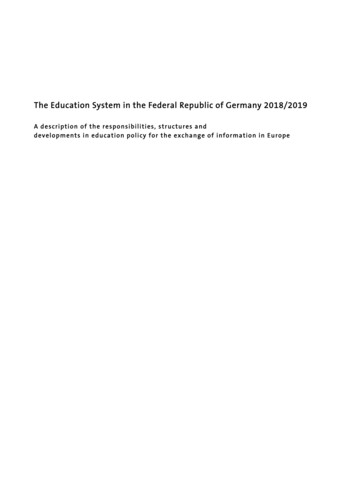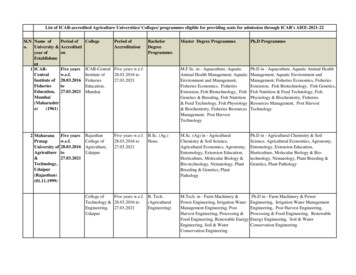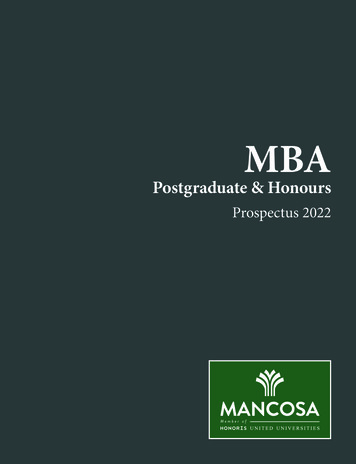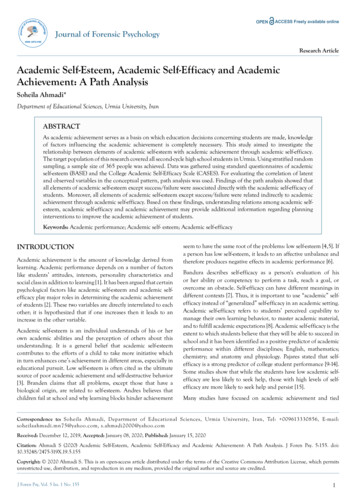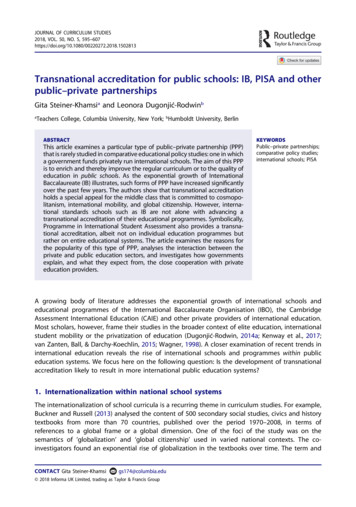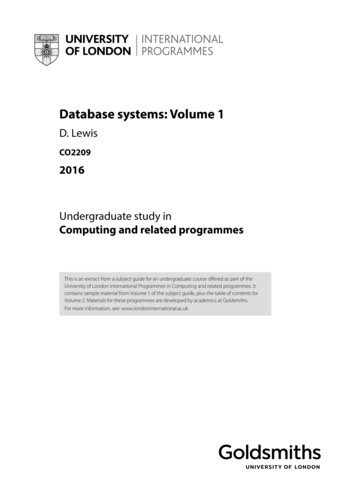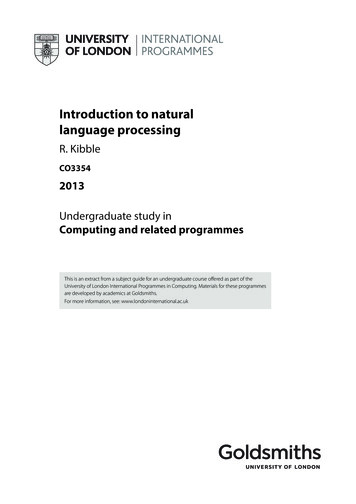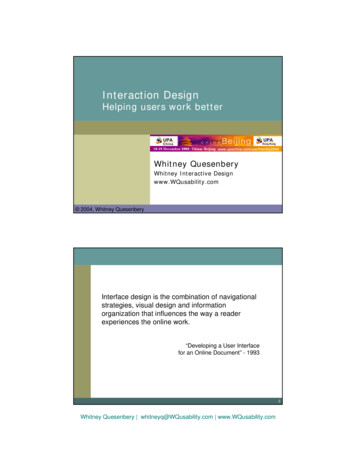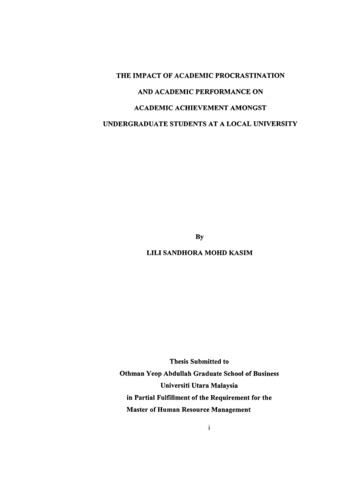
Transcription
Engineering2022Academic programmesand faculty informationCalendar, Part 11FORWARD TOGETHER SONKE SIYA PHAMBILI SAAM VORENTOE
EngineeringAccuracy, liability and changes Stellenbosch University has taken reasonable care to ensure that the information provided in the Calendar parts is asaccurate and complete as possible.Take note, however, that the University’s Council and Senate accept no liability for any incorrect information in theCalendar parts.The University reserves the right to change information in the Calendar parts at any time if necessary.Please note that the information in this Calendar part, and also in the other Calendar parts, is subject tochange, as and when necessary, for as long as uncertainty regarding the Covid-19 situation persists.The division of the Calendar PartPart 1Part 2Part 3Part 4Part 5Part 6Part 7Part 8Part 9Part 10Part 11Part 12Part 13The Calendar is divided into 13 parts.Parts 1, 2 and 3 of the Calendar contain general information applicable to all students. Make sure that you understandall provisions in Part 1 (General) of the Calendar that are applicable to you.Parts 4 to 13 of the Calendar are the Faculty Calendar parts.CalendarGeneralBursaries and LoansStudent FeesArts and Social nomic and Management SciencesEngineeringMedicine and Health SciencesMilitary ScienceAvailability of the Calendar parts The electronic versions of the Calendar parts are available at www.sun.ac.za/Calendar.Parts 1 to 12 are available in both English and Afrikaans. Military Science (Part 13) is only available in English.i
EngineeringTable of contentsHow to use this Calendar part . 11General Information . 31.1How to communicate with the Faculty and the University . 31.1.1Using your student number . 31.1.2The Faculty’s contact details . 31.1.3The University’s contact details . 41.2Language at the University. 41.3The engineering profession . 41.41.51.61.3.1Definition of engineering . 41.3.2The role of the professional engineer . 51.3.3Registration as professional engineer . 5What it means to register as professional engineer . 51.3.3.2Requirements for registration . 51.3.3.3Accreditation of programmes by ECSA . 51.3.3.4International recognition of programmes . 5The Faculty . 51.4.1History . 51.4.2Engineering building complex . 61.4.3Faculty of Engineering Computer User Area (FECUA) . 71.4.4SET Outreach Programme . 7Departments and engineering disciplines . 71.5.1Department of Civil Engineering . 71.5.2Department of Electrical and Electronic Engineering . 71.5.3Department of Industrial Engineering . 81.5.4Department of Mechanical and Mechatronic Engineering . 81.5.5Department of Process Engineering . 9Rules of the Faculty . 91.6.1Provisions relating to assessment . 101.6.2Absence from assessments . 101.6.3Academic work during vacations . 101.6.41.71.3.3.1IT-infrastructure. 101.6.4.1Responsibility to read e-mails regularly . 101.6.4.2Annual levy . 101.6.4.3Connecting your own hardware to the University IT network. 101.6.4.4User area etiquette. 101.6.4.5E-mail and network etiquette . 101.6.4.6Misuse of the IT infrastructure . 10Awards and prizes . 111.7.1Faculty-wide . 111.7.1.1The Dean’s Award for Outstanding Achievement . 111.7.1.2The ECSA Medal of Merit. 111.7.1.3The Jac van der Merwe Prize for Innovation . 111.7.1.4Lecturer of the Year . 111.7.1.5Upcoming Researcher of the Year . 111.7.1.6Annual Teaching Excellence Award . 111.7.1.7Honorary Member of the Faculty . 111.7.2Civil Engineering . 111.7.3Electrical and Electronic Engineering . 121.7.4Industrial Engineering . 121.7.5Mechanical and Mechatronic Engineering. 131.7.6Process Engineering . 13ii
Engineering2Undergraduate Programmes . 152.1Qualifications and fields of study . 152.2ECSA accreditation . 152.3Undergraduate enrolment management . 152.4How to be admitted to a BEng programme. 162.4.12.4.2Applicants with no prior tertiary learning . 162.4.1.1Admission requirements for BEng (4yr) and BEng (EDP) . 162.4.1.2Selection process for BEng (4yr) . 162.4.1.3Selection process for BEng (EDP) . 172.4.1.4Application procedure for BEng (4yr) and BEng (EDP) . 17Applicants with prior tertiary learning . 172.4.2.1Residency requirement for obtaining a BEng degree from Stellenbosch University . 182.4.2.2How to obtain recognition for modules from other programmes or institutions . 182.4.2.3Applicants from other programmes at Stellenbosch University . 182.4.2.4Applicants from BEng, BScEng and BSc programmes at other universities in South Africa . 192.4.2.5Applicants with a National Diploma, National Higher Diploma, BEngTech or BTech degree fromanother university in South Africa. 192.4.2.6Applicants from universities outside of South Africa . 212.4.2.7Recognition of prior learning not covered in the sections above . 212.5Changing your BEng degree programme. 222.6Renewing your registration as an undergraduate student each year . 222.6.1Requirement to renew registration annually . 222.6.2Calculating HEMIS credits . 222.6.3Requirements for renewal after one year of study in a BEng (4yr) . 232.6.4Requirements for renewal after two or more years of study in a BEng (4yr) . 232.6.5Requirements for renewal after one year of study in a BEng (EDP) . 232.6.6Requirements for renewal after two or more years of study in a BEng (EDP) . 232.6.7Applying for readmission if you did not meet the requirements for renewal . 242.6.8Requirements for renewal after you have been readmitted . 242.7Rules for following modules from more than one year of study . 242.8Dean’s concession examinations. 252.9Improving your final mark. 252.10 Electronic pocket calculators . 252.11 Programme structure and content . 262.11.1 Interpreting the curriculum tables . 262.11.2 Curriculum of BEng (EDP) . 262.11.3 Curriculum of the first year of all BEng (4yr) programmes . 272.11.4 Curriculum of four-year BEng Chemical Engineering . 282.11.5 Curriculum of four-year BEng Civil Engineering . 292.11.6 Curriculum of four-year BEng Electrical and Electronic Engineering . 302.11.7 Curriculum of four-year BEng Industrial Engineering . 342.11.8 Curriculum of four-year BEng Mechanical Engineering. 352.11.9 Curriculum of four-year BEng Mechatronic Engineering . 372.11.10 Measures for repeating modules that have been removed from programmes . 393Postgraduate Programmes . 403.1Qualifications and fields of study . 403.2Postgraduate admission model for the Faculty of Engineering . 413.3Recognition of prior learning . 423.4Provisions regarding enrolment and conversion of programmes. 423.4.1Periods of enrolment. 423.4.2Continued enrolment during the maximum period of enrolment . 433.4.3Continued enrolment after the maximum period of enrolment . 433.4.4Interruption of studies. 43iii
Engineering3.53.63.73.843.4.5Permission required for part-time enrolment . 433.4.6Converting between postgraduate programmes . 433.4.6.1From PGDip (Eng) to MEng . 433.4.6.2From MEng to MScEng . 433.4.6.3From MEngSc and MEng (Research) to PhD . 43Postgraduate Diploma in Engineering (PGDip (Eng)) . 443.5.1Admission requirements . 443.5.2Selection 443.5.3Application procedure . 443.5.4Duration and period of enrolment . 443.5.5Pass requirements . 443.5.6Programme structure . 44Master of Engineering (MEng) . 443.6.1Admission requirements . 443.6.2Selection 443.6.3Application procedure . 443.6.4Duration and period of enrolment . 453.6.5Programme description: MEng (Structured) . 453.6.6Programme description: MEng (Research) . 453.6.7Examination and requirements to pass: MEng (Structured) . 453.6.8Examination and requirements to pass: MEng (Research) . 46Doctor of Philosophy (PhD) in the Engineering Faculty . 463.7.1Admission requirements and continued admission after your first year of study . 463.7.2Selection 463.7.3Application procedure . 463.7.4Duration and periods of enrolment. 463.7.5Programme composition and requirements for obtaining the PhD degree . 473.7.6Submitting your dissertation for examination . 47Doctor of Engineering (DEng). 473.8.1Admission requirements . 473.8.2Selection 483.8.3Application procedure . 483.8.4Duration and period of enrolment . 483.8.5Programme composition and requirements for obtaining the DEng degree. 483.8.6Examination of the dissertation . 48Undergraduate Subjects, Modules and Module Contents . 494.1Explanation of numbering system and abbreviations . 494.2Determining final marks . 504.3Undergraduate subjects, modules and module contents . 51Appendix A: Faculty-wide Awards . 91A.1 Chancellor’s Medal . 91A.2 Dean’s Award for Outstanding Achievement . 91A.3 ECSA Merit Medal . 91A.4 Engineering – Lecturer of the Year . 92A.5 Engineering – Researcher of the Year . 93A.6 Engineering – Upcoming Researcher of the Year. 93A.7 Engineering – Teaching Excellence Award . 93A.8 Honorary Members of the Faculty . 94Index of Undergraduate Subjects and Modules . 95iv
EngineeringHow to use this Calendar partThis section gives you guidelines for finding particular information in the different chapters in this Calendar part. Consult thetable of contents for the page numbers of the chapters referred to below.Where to find informationProspective undergraduate students The General Information chapter contains information about:o Communication with the Faculty and the University, which includes an explanation of the concept “studentnumber” as well as relevant contact details where you can refer important enquiries to;o Language at the University;o The degree programmes that you can enrol for and the qualifications that you can obtain as well as importantprovisions relating to assessment;o Other rules that apply to all students; ando Awards and prizes available to engineering students.The Undergraduate Programmes chapter contains information about:o The minimum admission and selection requirements for the various study programmes;o Admission based on the recognition of prior learning;o The Faculty’s undergraduate study programmes; ando The modules that must be taken per academic year for the different study programmes, with choices whereapplicable.The Undergraduate Subjects, Modules and Module Contents chapter contains:o An explanation of subjects as opposed to modules;o An explanation of the different digits used for the numbering of modules in the Undergraduate Programmeschapter; ando Definitions of prerequisite pass, prerequisite and corequisite modules.An alphabetical list of undergraduate subjects and modules is available in the back of this Calendar part.Prospective postgraduate students The General Information chapter contains information about:o Communication with the Faculty and the University, which includes an explanation of the concept “studentnumber” as well as relevant contact details where you can refer important enquiries to;o Other rules that apply to all students in the Faculty; ando Awards and prizes available to engineering students.The Postgraduate Programmes chapter contains information about:o The Faculty’s postgraduate study programmes;o The minimum admission requirements for the various study programmes;o Specific closing dates for applications, and other relevant information, for example selection for admission; ando The composition of programmes and examination requirements.Registered undergraduate students The General Information chapter contains information about:o Communication with the Faculty and the University with relevant contact details where you can refer importantenquiries to;o Language at the University;o Other rules that apply to all students in the Faculty; ando Awards and prizes available to engineering students.The Undergraduate Programmes chapter contains information about:o The Faculty’s policy on the granting of dean’s concession examinations to final-year students;o The Faculty’s undergraduate study programmes;o The modules that must be taken per academic year for the different study programmes, with choices whereapplicable; ando Renewing your registration as undergraduate student every year.The Undergraduate Subjects, Modules and Module Contents chapter contains:o An explanation of subjects as opposed to modules;o An explanation of the different digits used for the numbering of modules in the Undergraduate Programmeschapter;o The abbreviations and definitions used for the teaching loads of individual modules;o An indication at each module of what its teaching load is;1
EngineeringDefinitions of prerequisite pass, prerequisite and corequisite modules, as well as an indication at each modulewhich of the requisites apply to it, if any;o How individual modules are assessed, especially where a module is subject to flexible assessment; ando An explanation of how final marks are determinedAn alphabetical list of undergraduate subjects and modules is available in the back of this Calendar part.o Registered postgraduate students The General Information chapter contains information about:o Rules that apply to all students; ando Awards and prizes for engineering students.The Postgraduate Programmes chapter contains information about:o The Faculty’s postgraduate study programmes;o Provisions relating to maximum periods of enrolment and the interruption of master’s or doctoral studies; ando The composition of programmes and examination requirements.2
Engineering1General Information1.1 How to communicate with the Faculty and the University1.1.1 Using your student numberThe University allocates a student number to you when you apply to study at the University.The student number is your unique identification to simplify future communication with the University.Use your student number every time you communicate with the Faculty and the University.1.1.2 The Faculty’s contact detailsDirect communication with the Faculty to one of t
Engineering i . Accuracy, liability and changes Stellenbosch University has taken reasonable care to ensure that the information provided in the Calendar parts is as
